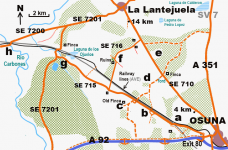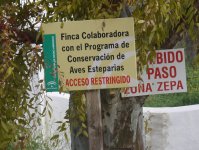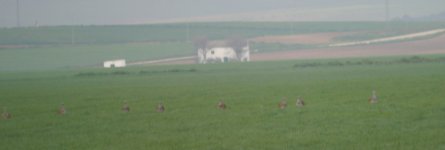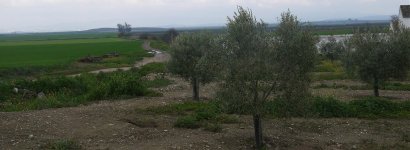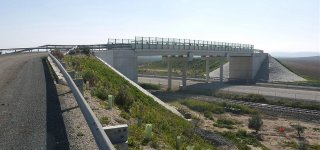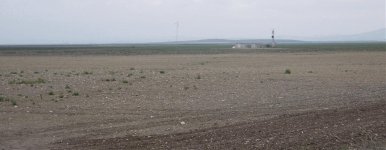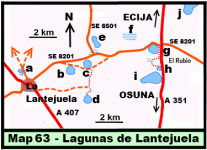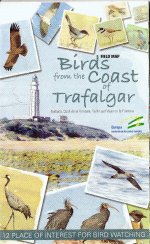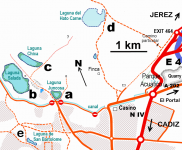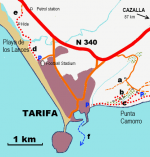Lagunas de Lantejuela
These notes have been taken from my revised account of the area in the latest 'edition of my notes'. See the map for locations & further details.
I originally omitted this site from my notes as they were both rather far from my base in Cadiz Province and, on my original visit, bone dry and birdless. However after several wet winters I found them to stuffed with birds. I was also persuaded by the fact that it's the nearest site to Alcala de los Gazules that has Great Bustard, Black-bellied Sandgrouse and Roller! The village has also hosted a modest ‘bird fair’ and there are plans to develop ornitho-tourism here. Despite this they are still threatened by agricultural development so the presence of visiting birders may may do some good. I revised these notes in March following a short visit in February. I plan to return again in May and check out a few points – esp. access for Laguna de Ruiz Sanchez.
As suggested in the opening paragraph, these lakes often dry out in summer or even remain dry throughout the winter – hence most ‘lagunas’ have the alternative name ‘hoya’ (= depression). Laguna del Gobierno (a) off Avenida de la Vereda de la Huerta in the village may be the exception as it seems, in part, to be an old water treatment works. I’ve yet to explore this laguna which apparently has some basic hides. Some of the reserve is visible from the road, but, according to Dave Gosney, permission to visit the reserve is needed (contact
[email protected]). Tracks and senderos head north from here into the ‘campo’ and should be worth exploring as both Great and Little Bustards have been seen in this area. It is also worth following the SE 700 towards Fuentes de Andalucia as in summer Roller often perch on the pylons/wires along this route. A track on the right (c4km north of La Lantejuela) appears to link up with those near the laguna and may be worth exploring. Initially it follows a well vegetated canal which should attract small passerines.
Taking theSE 708 west from La Lantejuela towards for El Rubio, after about 2.5km from the village a good track runs across the farmlands on your right – apparently part of the plans to encourage ‘eco-tourism’. After c700m you get a view across Laguna/Hoya de la Verde Sal (b) which, I suspect is more a ‘hoya’ than a ‘laguna’ since even in what seems a wet year it was dry.(According to one source a sendero passes to the west of the hoya to reach Laguna de Pedro Lopez). Look for Stone Curlew here and the habitat looks good for Black-bellied Sandgrouse (although rare in this general area).
The track passing Verde Sal continues to give good views of Laguna Ballestera (c) which is also viewable from the SE 708 (although parking along the road is limited). Unlike the access to this track further along the SE 708 there are no restrictive notices coming from this direction (although if the water level in the laguna is high further progress along the track is impossible). Take care not to spook the birds which can be very close to the shore here. Ballestera often has several hundred Flamingos, but also check carefully for Lesser Flamingo which has occurred several times. Four Ruddy Shelduck were also present in the winter of 2012/2013. Many Ruff and other waders, Whiskered Tern, ducks (inc. Red-crested Pochard and White-headed), Black-necked Grebe and numerous Coots present. Red Kite are frequent in winter. Both Montagu’s Harrier and Lesser Kestrel are common in summer and Black-winged Kite are now resident here.
The track behind Laguna de Ballestera rejoins the SE 708 about 1km further west (e). There's a large sign here showing a walking route to Laguna Pedro de Lopez (f) which, if wet, holds those species already noted for more accessible lagunas. (This noticeboard is flanked by an old notice suggesting this is a ‘restricted military area'; obviously you can walk this route, but it's unclear whether you can drive along it). This should be more accessible from (c) assuming the water level is not too high. Note that walking to this laguna is not advised during the heat of the summer.
Back on the SE 708 there's a T-junction just after you pass Laguna de Ballestera where, by going north, on the SE 705 you pass Laguna Consuegra (d). In wet springs the junction may overlook flooded fields which can have good numbers of Lapwing, Black-winged Stilt and Gull-billed Terns.The laguna itself, accessed by a rough track running along its eastern rim, holds many of the species noted under Ballestera (inc. vagrant Lesser Flamingo).
Back on the now familiar SE 708 continue towards the A 351 and El Rubio. In spring 2011 there was a large distant flooded area to the north of the road which was packed with Flamingos and waders (inc. Greenshank, Green Sandpiper, Dunlins, etc). However, although probably always 'damp' this area is not always flooded.
Roughly 10 km after leaving the La Lantejuela you reach the A 351 (Ecija-Osuna road) and with it the Hoya/Laguna de la Turquillas (g). Although often dry and when wet clogged with reeds, during passage it attracts dozens of Whiskered, and a few Black Terns (check for White-winged Black too), Squacco Heron, Purple Gallinule and White-headed Ducks. Marbled Duck sometimes appear here so scan carefully. (Note that parking here can be tricky). The warm tarmac road tempt Collared Pratincole. to rest perilously. Whiskered Tern, Purple Heron & Little Bittern breed. Evidently a sendero (footpath) skirts the edge of the laguna towards the Lagunas de Calderon (h).
There are two Lagunas de Calderon – Chica and Grande. The tiny Laguna de Calderon Chica tends to be the wetter of the two and presumably has many of the same species as Turquillas. Immediately to the south is the larger neighbour Laguna de Calderon Grande. However, whilst it has a greater surface area than its near name sake, it’s much shallower and more often deserves to be called a ‘hoya’. Once more pulling off the road here is tricky, but alt least there’s a track you could pull onto at its southern end. (Promised touristic developments here may improve matters).
Anywhere along the A 351 has the potential to turn up Great or Little Bustards, but finding somewhere safe to pull over is always problematical (although I’m probably more cautious than some). The best areas look to be to the west left 5-6 km north of the junction of the SE 708/A 351.
To the east, set amongst distant hills tantalisingly shimmering in the heat 1-2 km from the road lies the Laguna de Ruiz Sanchez (j); once the largest lake (356 hectares) in the complex and the second largest in Andalucia – only Fuente de Piedra is larger. Previously home to Marbled, Ferruginous & White-headed Duck and Crested Coot, a restoration project (started in 2006) aims to restore these species here. From the road Flamingos can be identified, but the numerous small waders and ducks using the laguna are too distant to be identified. However, a track c3 km from the junction of the A 351 (near the 14km marker) runs through olive groves towards the laguna and then loops round to run along parallel to its western shore. This route is used by cyclists and may be accessible by car. (There's also a still rougher less likely looking farm track at 11 km marker - see photo - which may allow approach on foot). Let me know if you explore either.
The local community is now growing aware of the potential of eco-tourism. In 2010 the complex was awarded a grant of 600,000€ to develop a visitors’ centre and encourage birdwatching. In April 2011 a small bird fair was held here, but the current financial crisis in Spain may have brought developments to an abrupt halt. However, the area continues to be threatened by agricultural development so the presence of visiting birders may may do some good.
See-
http://lantejuelaturismorural.blogspot.com/).
Note -the only laguna in the complex I can’t find is the Laguna de Cantera Romana – let me know if you find it!
I'll post photos once I've resized them!




